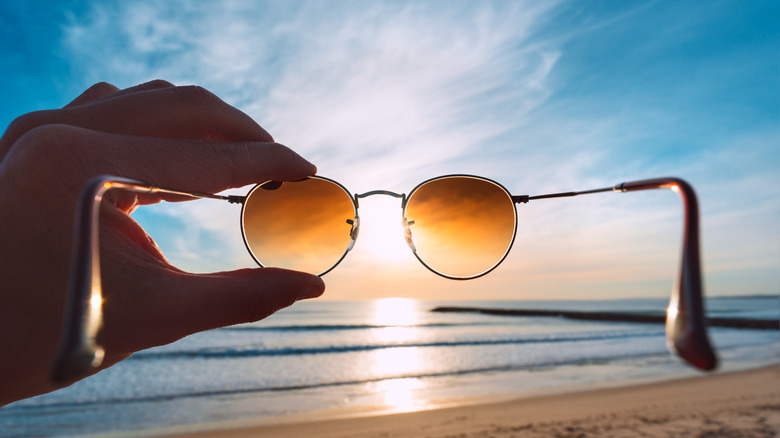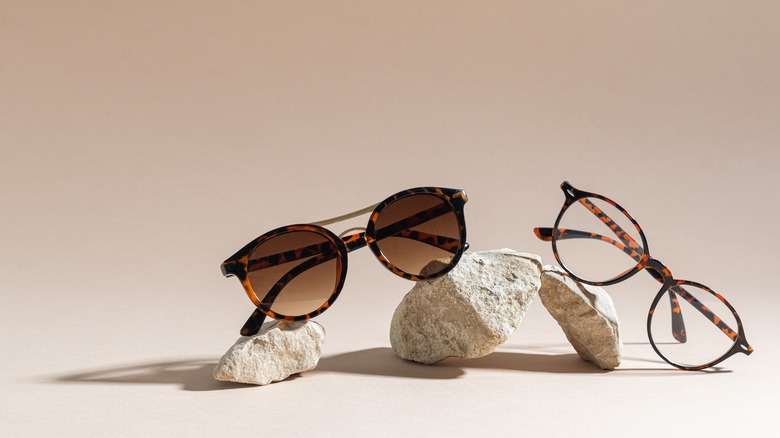Early Chinese Sunglasses Were Not Used To Protect Against The Sun
Where would we be without the Sun? Well, that's a bleak topic to dive into. According to How It Works magazine, the very oceans would freeze after about two weeks without its heat. The only real natural source of heat being the Earth's core isn't a desirable scenario by any stretch.
As reliant as the Earth is on the dear old Sun, though, it's also a deadly danger. According to NASA, the core of this mighty star measures about 27 million degrees Fahrenheit. It's not sure whether it wants to keep us all warm or vaporize us. Granted, this is a mood we can all empathize with, but it also makes something else very clear: Humanity has always both revered the Sun and battled to protect itself from its harmful rays.
Today's sunglasses serve as neat fashion statements and make us feel like the stars of 70's cop shows, but they have a primary purpose: to prevent us from having our eyes damaged by the Sun. The sunglasses created in China centuries ago, however, were used for a sneaky purpose by lawmakers.
Brilliant early uses of sunglasses
Like many essential objects that we often take for granted today, sunglasses have a long and intriguing history. The Canadian Museum Of Civilization boasts an exhibit that serves as an example of one of the earliest takes on sunglasses: A set of prehistoric Inuit snow goggles, reportedly from around the year 1200. They were discovered in the Arctic, per the museum, and were intended to protect against the dangers of reflected sun on the snow.
There are examples dating further back in history of such things being used for practical purposes. According to Pliny the Elder in his "The Natural History" (per Perseus), the infamous ancient Roman Emperor Nero "used to view the combats of the gladiators upon a smaragdus." The word "smaragdus" here meant a green precious stone (presumably an emerald), and John Bostock (per Perseus) even suggests the possibility that the stone formed a sort of lens to aid Nero's vision.
That last part might be a little fanciful, but there's no denying that sunglasses and primitive versions of them have had all kinds of purposes. The Torquay Museum states that sunglasses of the 1200s were used in Chinese courts. Judges would reportedly wear them so their faces wouldn't give them away in the courtroom.
From humble beginnings to worldwide fashion essential
Such sunglasses, Torquay Museum goes on, would also have had the functionality of protecting against the sun (so the name checks out), being made of quartz. Science Museum adds that they were referred to as Ai Tai (dark clouds covering the sun), and had numerous uses (such as in ceremonies). Most notably, perhaps, judges reportedly wore them to prevent themselves from giving anything away during an interrogation.
For many of us, creative uses for sunglasses don't really extend very far beyond putting a pair on our dogs or cats for a silly photo. This masterstroke, however, ensured that a judge didn't appear to be favoring one side or another, and would also perhaps have looked a little silly.
According to the BBC, English friar Roger Bacon is among the first of the brilliant minds associated with the development and refinement of spectacles. He also lived during the 1200s, and was a pioneer of the study of lenses and their interaction with light. The "sunglasses" of his time could do little more than block dazzling rays, but when Bacon and the brilliant minds that followed him developed lenses, they began to be used to correct issues like short- and long-sightedness too.


